The OnePlus One Review
by Joshua Ho on November 19, 2014 8:00 AM EST- Posted in
- Smartphones
- Android
- Mobile
- OnePlus
Camera UX
For the most part, the OnePlus One has a generally standard camera system for 2014 smartphones. With a 6P lens system, F/2.0 aperture, and Sony IMX214 camera sensor, the OnePlus One has a relatively standard camera system for today's smartphones. The focal length is similar to most smartphones on the market at a relatively wide 3.8mm length, which makes it equivalent to a 28mm focal length when accounting for the crop factor of the sensor. The front facing camera has an OmniVision OV5648 sensor, which is a 5MP, 1.4 micron, 1/4 inch sensor, with an F/2.0 aperture at 2.67mm focal length. This means that the field of view is similar to the rear-facing camera at about 29mm accounting for the crop factor.
While the camera hardware is relatively standard, the camera interface is definitely a unique take, and is the first time that I've been able to use Cyanogen's camera UI. In general, this UI feels like a mix of the old Google Camera, along with an immense amount of complication and not much explanation. For example, in the settings there's an ISO selection menu. While this is nothing to talk about normally, there's a setting called "Auto (HJR)". The only way for me to learn about this setting is by searching for it on Google, which explains that it favors higher ISOs to reduce the effects of shaky hands. As of the latest 44S update, this crashes the camera any time I try to take a photo in low light. To further explain the point, there are plenty of options in the video size setting, but a huge number of them are completely unexplained. While one might easily guess what 4K UHD or HD 1080p is, I find it difficult to believe that 4k DCI, CIF, or QCIF are self-explanatory. Interestingly enough, turning RAW capture on or off also has an effect on the maximum shutter speed, something that isn't actually detailed anywhere.
While an unfamiliar UI is not really a massive issue, there are some fundamental flaws with how the UI works. One of the most obvious flaws is the aspect ratio of the preview, which is 16:9, when output images can have a 4:3 aspect ratio. This makes it impossible to accurately frame an image. In order to do the ISO chart test, it was necessary to use Google Camera to frame the chart before switching back to the Cyanogen camera.
In addition to all of this, the scene selection UI doesn't have much thought put into it. All filters and all scene modes are integrated into a single menu, which is navigated by swiping up and down on the preview. This wouldn't really be an issue but when there are 31 options to swipe through this really gets to be a bit much to handle. There is a list option that can be found by going through the menus though, which is a bit better at organizing information. Unfortunately, most of the scene options are a bit nonsensical. The "night" modes don't actually change anything (ISO and shutter speed seem to be identical), and pretty much everything else is unclear on what it does. The one interesting mode is the slow shutter mode, which sets ISO to 100 and allows the exposure time to go as high as 8 seconds for high-quality photos on a tripod. This is also broken as of the 44S update, which causes the camera to crash until the phone is rebooted. I suspect that OnePlus is better off exposing full manual controls instead of trying to cover every possible edge case with a large number of scene modes that may or may not change anything. There's also no way to get a grid to try and frame images properly.
Speaking of ISO and shutter speed values, while the camera UI was mostly responsive in previous versions, around the 38R OTA I saw a dramatic shift in the auto exposure algorithm as it went from a maximum of 4500 ISO and around 1/11 second shutter speed to 4100 ISO and 1/6 second shutter speed. This has effectively made it impossible to use the camera at night, as there is no OIS present to reduce the effects of even slight hand shake. Overall, all of these issues make the OnePlus One quite frustrating to use as a camera.
Aside from these niggles with the camera application that can generally be resolved by using Google Camera, another area of evaluation is shot to shot latency, along with focus latency. To this end, the device was tested by pointing the camera at the ISO chart with strong lighting to be able to reach base ISO and timing how long the camera took to focus on an object along with how quickly the device could take a photo.
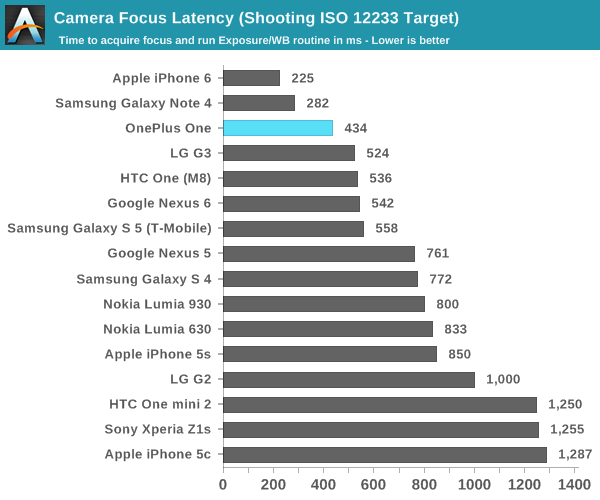
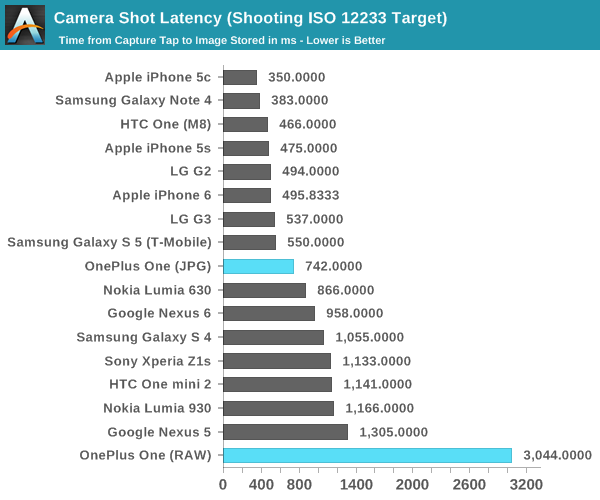
The OnePlus One does do surprisingly well in our focus test, setting a rather respectable focus latency around the same speed as the competition. On the other hand, the default capture speed is really quite long, although this is really mostly due to the RAW capture as turning off RAW capture dramatically speeds up response time in the camera to a much more respectable ~750 ms.


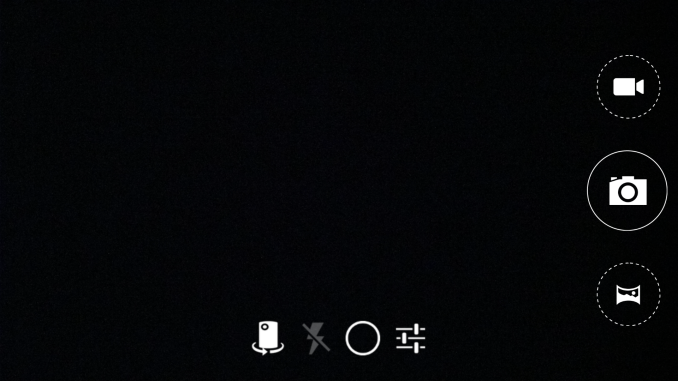

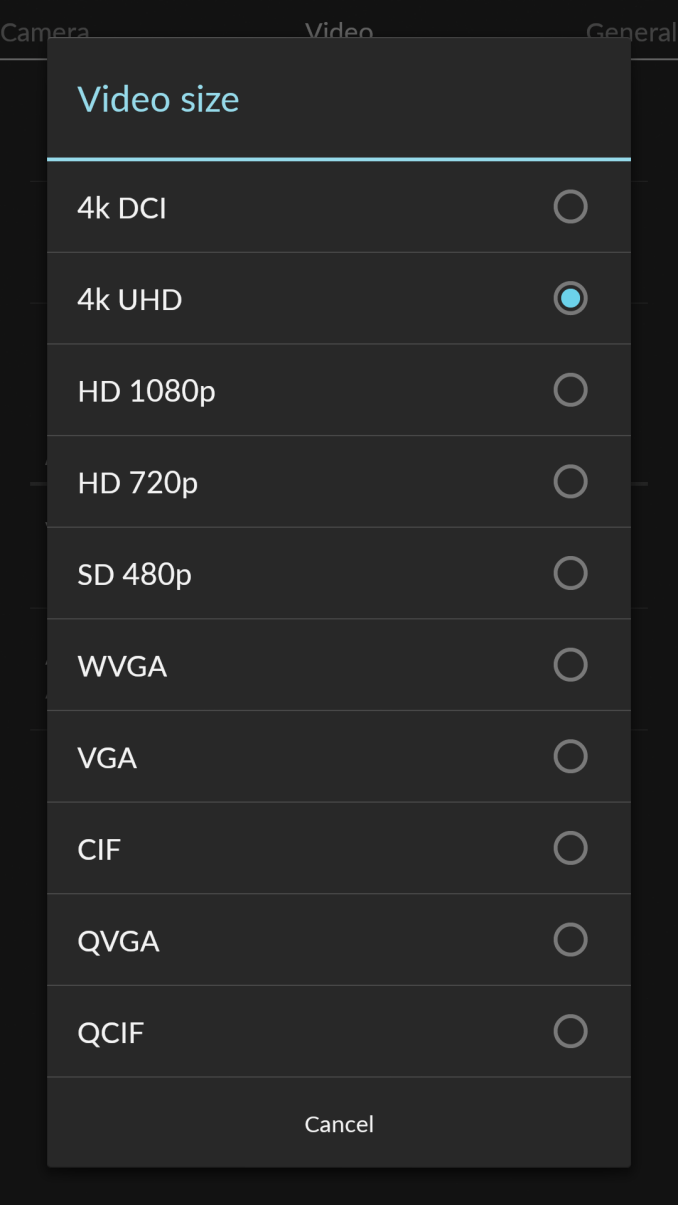


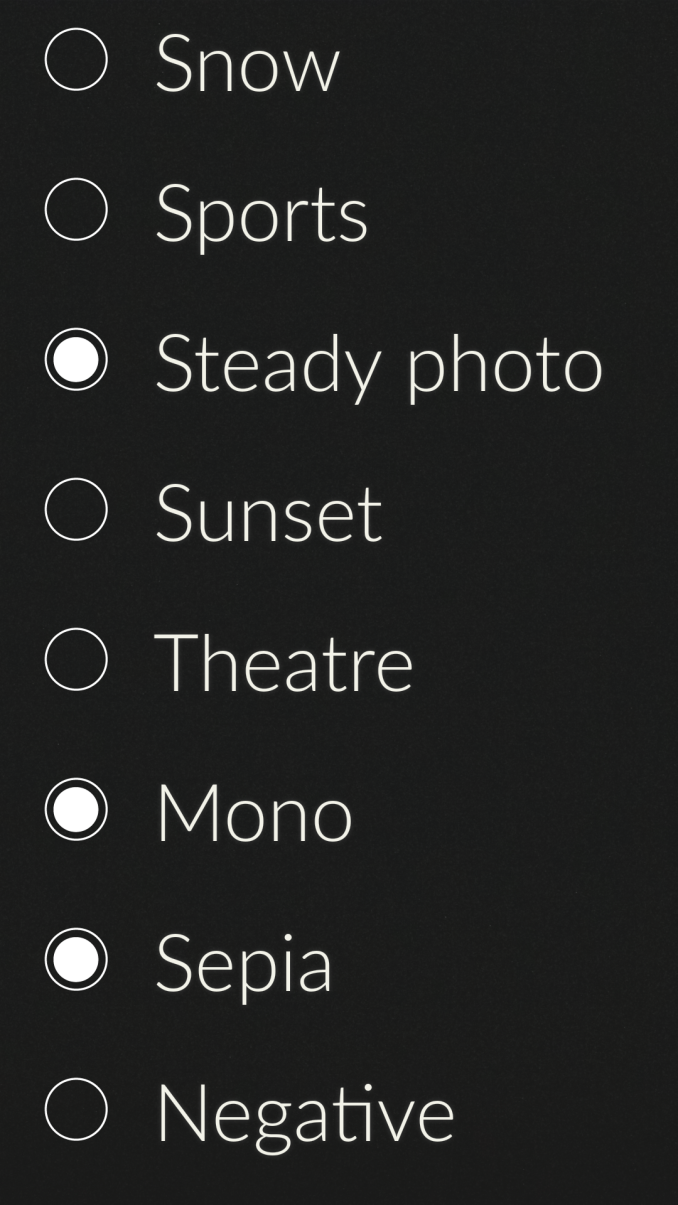
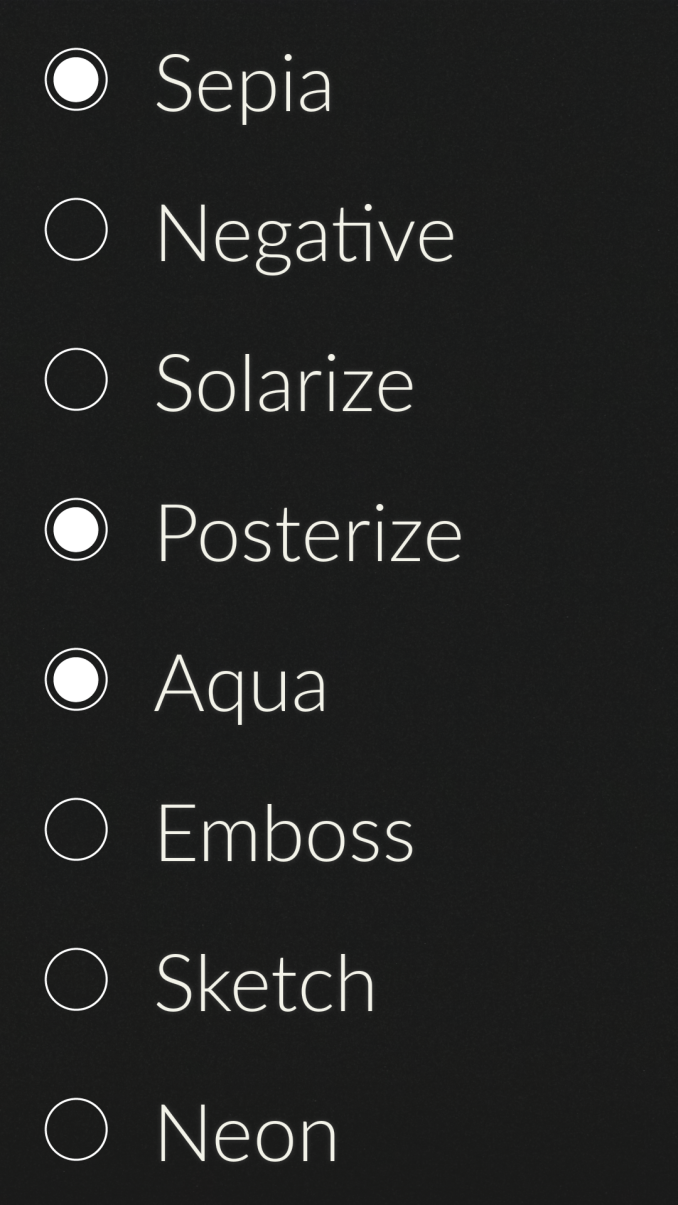
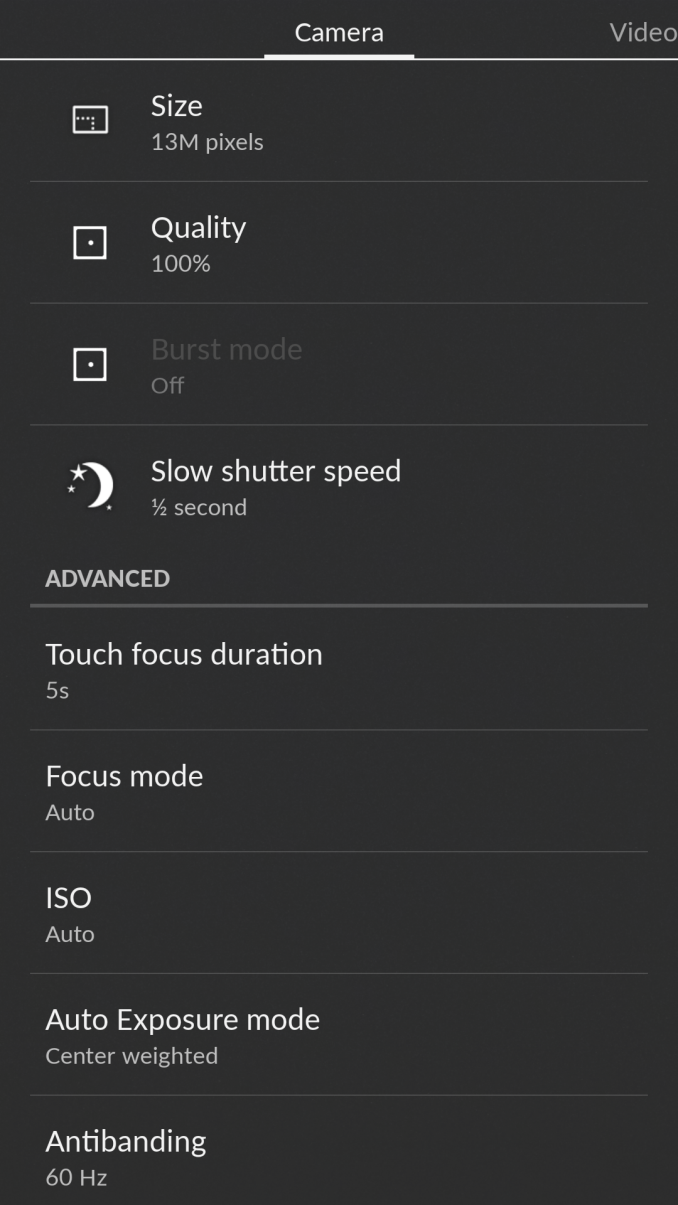









148 Comments
View All Comments
nspyraishn - Friday, November 21, 2014 - link
I would contend the "too big to use with one hand" issue is overblown. I have been using it for a while now and have no problem using it with one hand. MMV, but claiming "it's almost impossible to use it comfortably with one hand" is just plain not accurate, and reflects a strong bias by the reviewers against larger phones. I would contend that if you used the phone a bit longer, you would likely come to appreciate the larger "phablet" size, and find that particularly for its diE it's surprisingly comfortable to use due to innovative form factor design choices. Other than that, a solid review :)Socius - Friday, November 21, 2014 - link
How does it feel to be the idiot who benchmarked this phone on the "balanced" performance profile? Lol. Change CPU to performance mode in settings for serious gaming or benchmarking and you'll see those results jump significantly.Also regarding your comment about cheating...you're being disingenuous. Cheaters clock the chips higher than stock, and temporarily increase thermal limits in order to get performance that wouldn't ordinarily happen. The "cheating" by switching to 2.5GHz is actually a feature in the phone for "per application performance profile." The phone comes with "balanced" mode preselected. But runs An tutu in performance mode, which is a fully selectable and sustainable mode as even your benchmarks showed little to no throttling happening.
Poor review, IMO.
HubbaMaBubba - Friday, November 21, 2014 - link
Holy shit, I didn't notice that. For everyday usage balanced is the best though, so it makes the most sense for the benchmark.Socius - Saturday, November 22, 2014 - link
Actually for daily use I stick to power saver. Other phones benchmarked don't have the CPU profiler installed at stock. So for benchmarking, performance mode should be enabled. And even if you disagree with that, even though the other phones you're comparing to are running in performance mode all the time, you can't make the claim that this phone cheats on benchmarks by running in performance mode.And for the record...in performance mode, this phone dominates all other android devices.
mrex - Wednesday, November 26, 2014 - link
Lol, funny =) hopefully he checked also it is not running max 1036mhz. It is a known faulty setting, and easily fixed by enabling developer options and check that cpu is running at it should and not locked to max 1036mhz. I actually had that issue, and in the performance mode it was still running at 1036mhz before i checked that setting.mrex - Wednesday, November 26, 2014 - link
Hit the submit button accidentally. I was sarcastic about did he check the mhz before testing (his phone was running correctly), but if you feel your phone is slow, check your phone isnt set to max 1036mhz.Jc.ray - Friday, November 21, 2014 - link
I've been using it for a month. Besides some initial bugs to make it work properly which where solved in a couple of weeks I have no other complains. You might prefer to start using two hands for typing but many of us already where doing that with tiny iphone4, as for the rest I am able to manage everything in one hand which in my case is not particularly big. As for the phablet: yes, here is the measure, as much as I love it I haven't used my ipad mini not even once since I received oneplusone, you can just do everything here so, if any, biggest danger is how you scale your internet use for any porpoise with this devicejomo60 - Friday, November 21, 2014 - link
"First, the size is definitely too much to handle".The opo is 152.9mm x 75.9mm, the iphone 6+ is 158mm x78mm.
Your iphone 6+ review had no problem with a phone larger than the oneplus one, and rounded corners "feature" does not make a screen more reachable.
mrex - Wednesday, November 26, 2014 - link
What else can you expect nowadays? Unfortunately I feel that you dont get objective reviews about apple anymore from anandtech. This is a good example.neogodless - Friday, November 21, 2014 - link
Re: terrible camerahttp://robinwong.blogspot.com/2014/09/oneplus-one-...
The hardware of the camera is actually pretty good. There's no getting around the lack of OIS, but otherwise it works well enough when pair with good software and capable hands.
I've had the phone for two weeks. I have little experience with Android and none with Cyanogenmod, but I was not confused about the optional... options that allow you to customize your phone, if you, you know, want to.
The battery charges quickly on my AC charger and the included USB charger, but it charges really slowly on several other micro-USB chargers that I got with Nokia and Motorola handsets over the past two years.
I did notice a little weirdness to the feel of the touch screen, but I put an amFilm screen protector on there, and have no issues now.
I use the phone about the same as I've used smaller phones, though I guess I was never much for one-handed operation. I like the stability of holding the phone and then using my other hand to do all the things.
I think the bottom line is that there's very little you give up in comparison to phones that cost $300 more. I don't think there's anything you can't live without.